Have you ever craved a steak that’s packed with flavor but doesn’t require hours of preparation? Skirt steak might just be the solution you’ve been searching for. This versatile cut is celebrated for its rich, beefy taste and quick cooking time, making it perfect for busy weeknights or weekend grilling sessions. Whether you’re crafting tacos, stir-fries, or just enjoying it on its own, skirt steak is your ticket to restaurant-quality meals without the hassle. If you’re ready to elevate your cooking game with minimal effort, this cut is here to make dinnertime easier and more delicious for you.
List Of Contents
1. What is Skirt Steak?
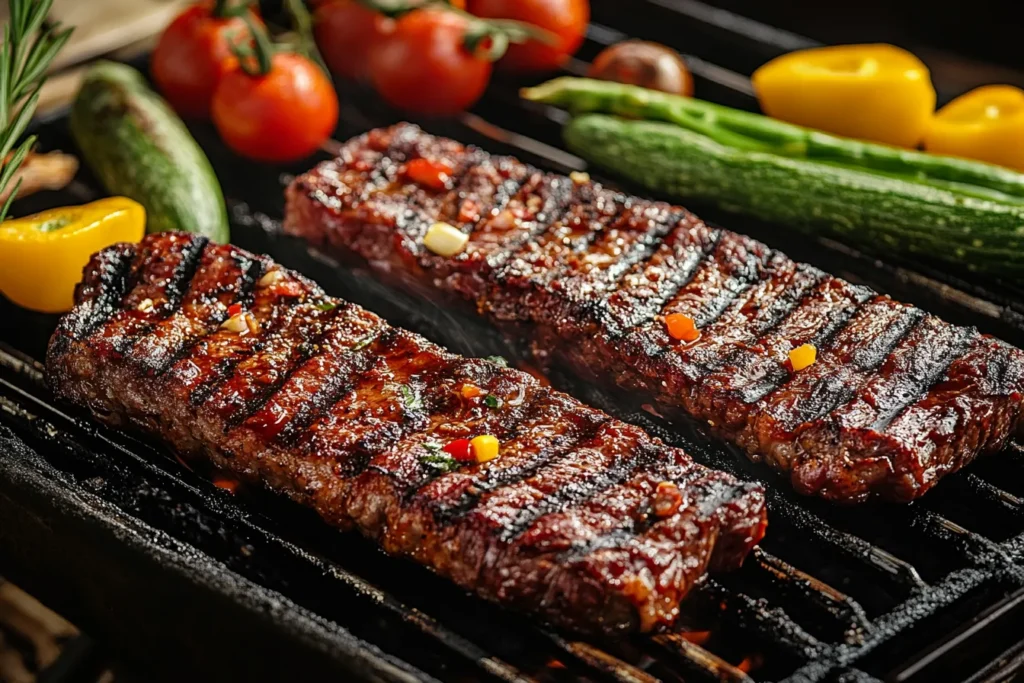
Skirt steak is a long, thin cut of beef derived from the diaphragm or lower chest of the cow. Known for its robust flavor and versatility, this cut is a favorite for grilling, stir-fries, and fajitas. Unlike more tender cuts like filet mignon, skirt steak is prized for its rich marbling and chewy texture, making it ideal for marinades and bold seasonings.
Historically, skirt steak has been popular in Mexican and Tex-Mex cuisines, often used in tacos and fajitas. As its flavor profile gained international recognition, it became a staple in cuisines worldwide, particularly in Asian stir-fry dishes and Argentinian asado. Check out more recipes here.
2. Nutritional Profile of Skirt Steak
Skirt steak is not just flavorful but also packed with essential nutrients:
- Calories: A 3-ounce serving of skirt steak typically contains around 200-250 calories, depending on preparation.
- Protein: High in protein, providing 20-22 grams per serving, making it an excellent option for muscle maintenance and growth.
- Fat Content: Contains 10-12 grams of fat per serving, with a mix of saturated and unsaturated fats.
- Vitamins and Minerals:
- Iron: Essential for oxygen transport and preventing anemia.
- Zinc: Plays a critical role in immune health.
- Vitamin B12: Supports energy metabolism and nerve function.
3. Health Benefits of Skirt Steak
High Protein Content for Muscle Growth
Protein is the building block of muscles, and skirt steak offers a complete protein profile, containing all essential amino acids. This makes it especially beneficial for athletes, bodybuilders, or individuals recovering from injuries. Check out more recipes here.
Rich in Iron
The heme iron found in skirt steak is highly bioavailable, meaning it is easily absorbed by the body. This helps prevent and treat iron-deficiency anemia, especially in women and vegetarians transitioning back to meat. Check out more recipes here.
4. Is Skirt Steak Lean or Fatty?
Fat Content Compared to Other Cuts
Skirt steak has a moderate fat content, with higher levels of marbling than lean cuts like sirloin or tenderloin. While this adds flavor, it also increases calorie density.
Saturated vs. Unsaturated Fats
The fat profile includes a mix of:
- Saturated fats: Linked to heart disease when consumed in excess.
- Unsaturated fats: Beneficial for heart health when replacing other saturated fats.
For a leaner option, trimming visible fat and choosing grass-fed varieties can reduce the saturated fat content. Check out more recipes here.
5. Essential Nutrients in Skirt Steak
Zinc for Immunity
Skirt steak is rich in zinc, a mineral crucial for:
- Supporting the immune system.
- Wound healing.
- Promoting healthy skin.
Vitamin B12 for Energy Metabolism
Vitamin B12, abundant in skirt steak, aids in:
- Red blood cell formation.
- Preventing fatigue and neurological disorders.
6. Skirt Steak in a Balanced Diet
Portion Size Considerations
Moderation is key when incorporating skirt steak into a healthy diet. A recommended portion is about 3-4 ounces per meal, balanced with fiber-rich sides like vegetables or whole grains. Check out more recipes here.
Pairing with Healthy Sides
- Grilled asparagus or zucchini for added fiber.
- Quinoa or brown rice for complex carbohydrates.
- Avocado-based salsa for healthy fats.
These pairings enhance the nutritional value and digestibility of skirt steak-based meals.
7. Risks Associated with Skirt Steak Consumption
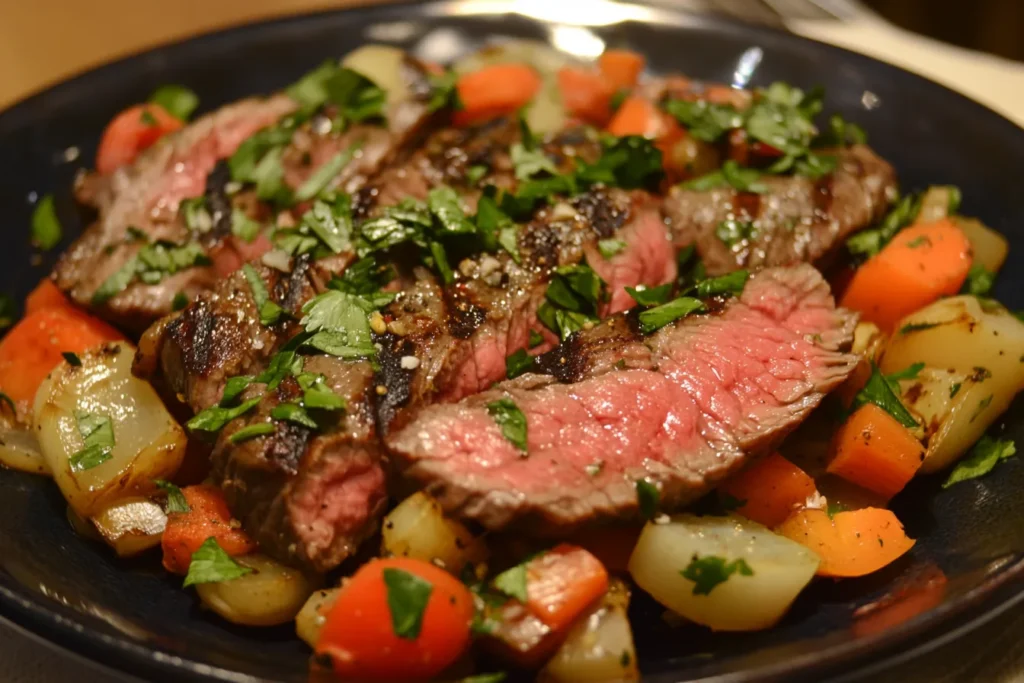
Red Meat and Heart Health
Excessive consumption of red meat, including skirt steak, has been linked to increased risks of:
- Cardiovascular disease due to saturated fats.
- High cholesterol levels, especially LDL (“bad cholesterol”).
Possible Links to Colon Cancer
Overeating processed and red meats has been associated with higher risks of colon cancer. To mitigate this, opt for healthier cooking methods and limit frequency of consumption.
8. Skirt Steak and Weight Loss
Can Skirt Steak Fit into a Weight-Loss Diet?
Skirt steak can be part of a weight-loss plan when prepared in lean, low-calorie ways. Choose methods like grilling, broiling, or air frying to avoid added fats.
Lean Preparation Tips
- Trim excess fat before cooking.
- Use herbs and spices for flavor instead of heavy sauces.
- Pair with low-calorie sides like leafy greens or roasted vegetables.
9. Comparing Skirt Steak to Other Cuts
Skirt Steak vs. Flank Steak
- Skirt steak has a richer flavor but is slightly higher in fat.
- Flank steak is leaner and easier to digest, making it ideal for those monitoring calorie intake.
Comparison to Poultry or Fish
- Skirt steak offers higher iron and zinc levels than chicken or fish.
- Fish provides more omega-3 fatty acids, making it better for heart health.
10. The Role of Cooking Methods
Grilling vs. Frying
Grilling skirt steak is a healthier option than frying, as it:
- Reduces added fats.
- Preserves its natural juices and flavor without excess oil.
Healthier Alternatives
Try baking or air frying to retain nutrients while reducing unhealthy fats. For an extra health boost, marinate the steak in olive oil, lemon juice, and garlic to enhance flavor without adding calories.
11. Skirt Steak for Athletes and Bodybuilders
Protein Requirements for Athletes
Skirt steak is a powerhouse of protein, providing up to 22 grams per 3-ounce serving. For athletes and bodybuilders, it supports:
- Supports muscle recovery and growth thanks to its abundant amino acids.
- Sustained energy levels, especially when paired with complex carbohydrates.
For optimal results, skirt steak is best consumed post-workout, as its iron and B12 content helps replenish energy and oxygen transport.
Skirt Steak as a Post-Workout Recovery Food
Skirt steak is an excellent option for restoring minerals lost during intense exercise, thanks to its combination of iron and zinc. Pair it with a baked sweet potato or quinoa for a balanced recovery meal.
12. Skirt Steak for People with Special Diets
Is Skirt Steak Suitable for Keto or Paleo Diets?
Both keto and paleo diets emphasize high-protein, low-carb eating, making skirt steak an excellent fit. Its moderate fat content supports keto’s emphasis on healthy fats, while its natural, unprocessed state aligns with paleo guidelines.
Considerations for Low-Sodium Diets
While skirt steak itself is naturally low in sodium, marinades and seasonings can increase sodium levels significantly. To make it suitable for a low-sodium diet:
- Use fresh herbs like rosemary or thyme for flavor.
- Avoid pre-packaged seasonings high in salt.
13. Ethical and Environmental Concerns
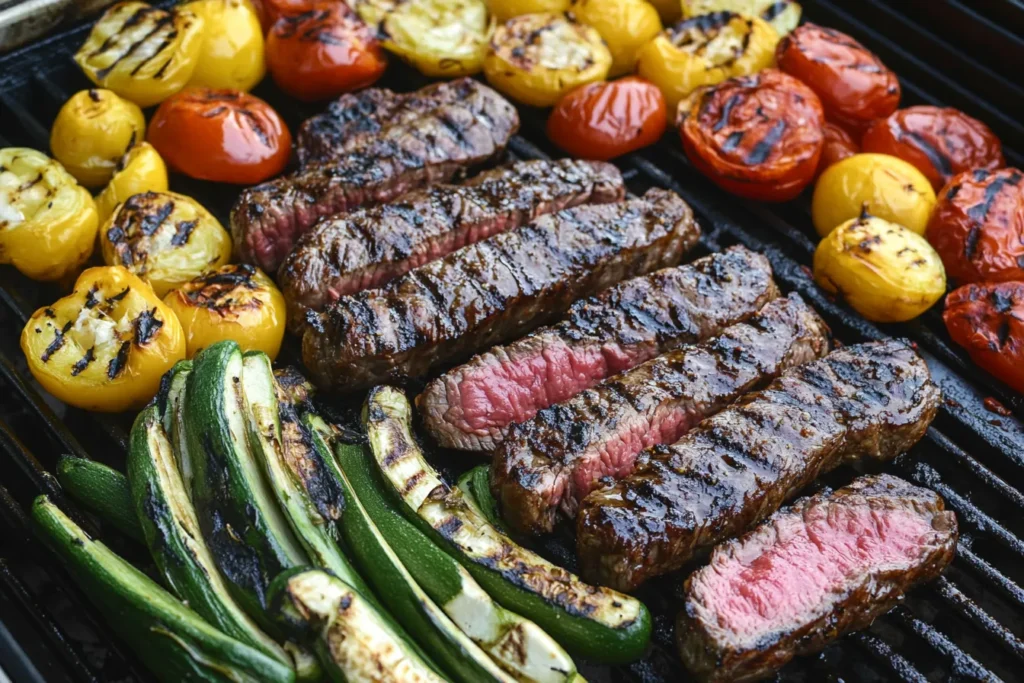
Sustainability of Beef Production
The environmental impact of beef farming is a significant consideration, as conventional beef farming is often associated with high greenhouse gas emissions. Furthermore, it contributes to the overuse of water and land resources, making sustainability a key factor in choosing beef products.
Grass-Fed vs. Grain-Fed Skirt Steak
Grass-fed skirt steak is more sustainable and:
- Contains higher levels of omega-3 fatty acids.
- Avoids the use of synthetic hormones and antibiotics.
By choosing grass-fed options, consumers can reduce their environmental footprint while enjoying better nutritional quality.
14. Organic vs. Conventional Skirt Steak
Nutritional Differences
Organic skirt steak is often:
- Lower in unhealthy fats due to natural feeding practices.
- Free from synthetic hormones and antibiotics, reducing potential health risks.
Benefits of Choosing Organic
- Better for the environment due to sustainable farming.
- Higher nutrient density compared to conventionally farmed beef.
15. Skirt Steak and Cholesterol
Effects on LDL and HDL Cholesterol
Skirt steak’s saturated fat content can raise LDL (“bad”) cholesterol levels if consumed in excess. However, pairing it with foods rich in soluble fiber, like beans or oats, can help balance its effects.
How to Balance with Heart-Healthy Foods
To mitigate cholesterol concerns, you can pair skirt steak with avocado, as it helps boost HDL (“good”) cholesterol. Additionally, including leafy greens like spinach, which are rich in heart-protective nutrients, further enhances the meal’s cardiovascular benefits.
16. Red Meat Guidelines by Health Organizations
USDA Recommendations
The USDA suggests limiting red meat consumption to about 3-4 ounces per serving and no more than 2-3 servings per week. This helps reduce risks of chronic diseases while allowing for balanced nutrition.
World Health Organization Insights
The WHO classifies processed red meat as a carcinogen and recommends moderation in red meat intake. While skirt steak is unprocessed, overconsumption can still pose health risks.
17. Skirt Steak and Digestive Health
How Red Meat Affects Digestion
While red meat like skirt steak is nutrient-dense, it can be harder to digest compared to plant-based proteins. Consuming it in moderation and pairing it with fiber-rich foods like legumes or whole grains can improve digestion.
Importance of Fiber-Rich Accompaniments
Adding high-fiber sides helps:
- Prevent constipation.
- Reduce the risk of colon cancer linked to excessive red meat consumption.
18. The Role of Marination
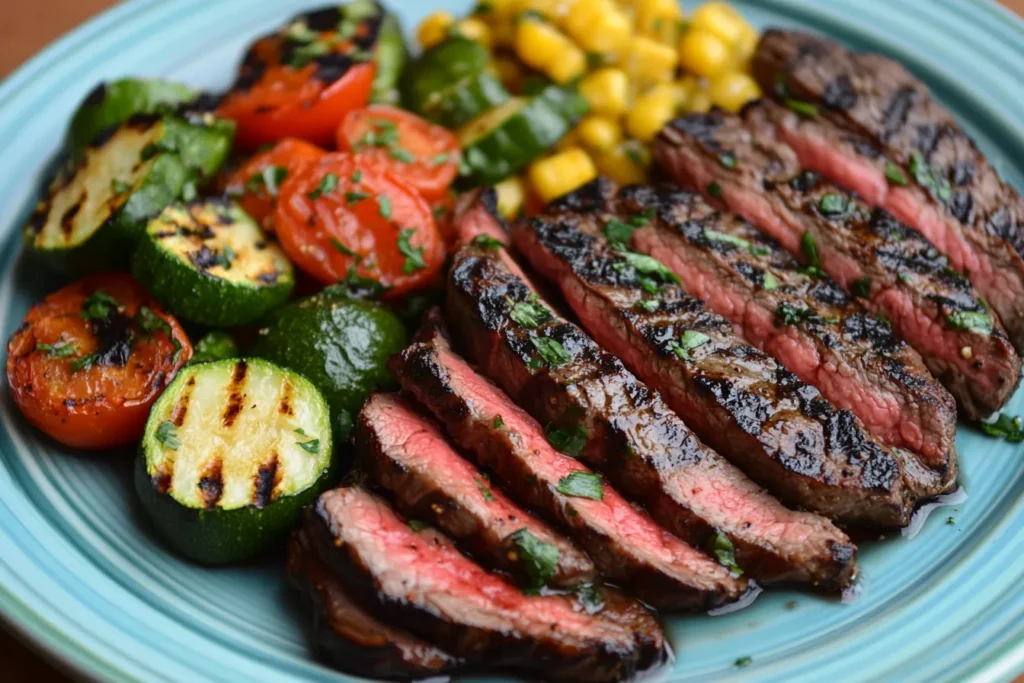
Does Marination Reduce Carcinogens?
Grilling red meat at high temperatures can produce carcinogens like heterocyclic amines (HCAs). Marinating skirt steak in acidic ingredients like lemon juice or vinegar can significantly reduce these compounds.
Healthiest Marinades for Skirt Steak
Opt for marinades with:
- Olive oil for heart-healthy fats.
- Garlic and turmeric, which have anti-inflammatory properties.
- Citrus juice for added vitamin C.
19. Skirt Steak in Global Cuisines
How Skirt Steak is Enjoyed Worldwide
Skirt steak is a versatile ingredient in global cuisines:
- Mexico: Used in fajitas with onions and peppers.
- Argentina: Grilled in asado-style with chimichurri sauce.
- Asia: Stir-fried with soy sauce, ginger, and vegetables.
Cultural Variations in Preparation
The preparation techniques vary but focus on enhancing its bold, beefy flavor with complementary spices and sides.
20. Alternatives to Skirt Steak
Plant-Based Options for Similar Nutrition
For those avoiding red meat, plant-based alternatives like seitan or tempeh can provide comparable protein levels. These options are:
- Lower in fat.
- Rich in fiber and free from cholesterol.
Other Lean Meats as Substitutes
Cuts like chicken breast or turkey provide:
- Leaner protein options.
- Less saturated fat compared to skirt steak.
21. Recipes and Preparation Tips
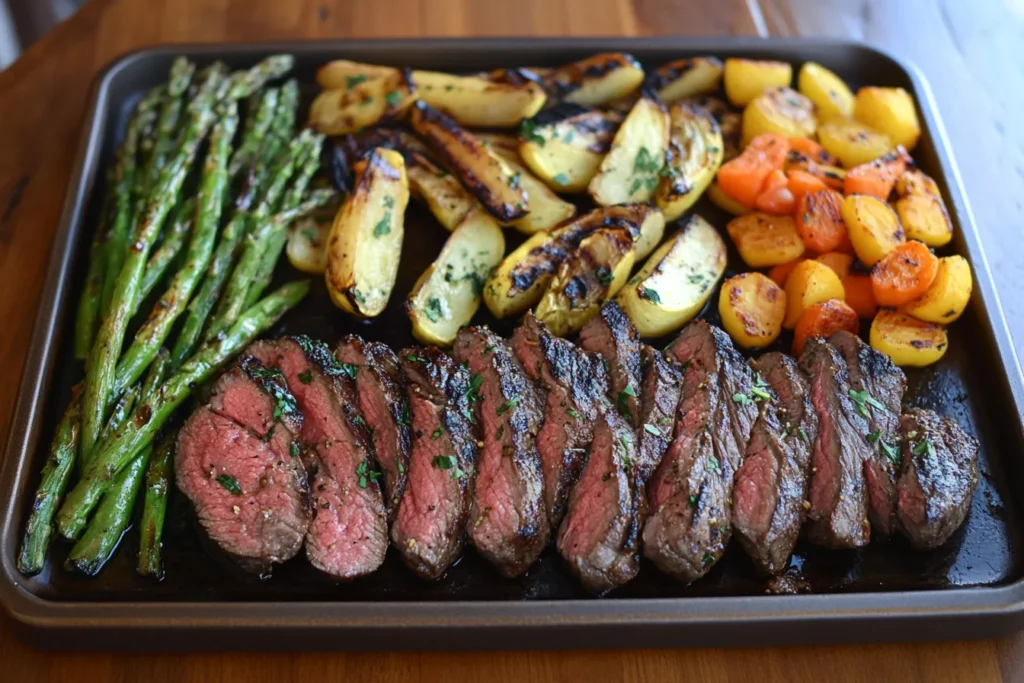
Quick, Healthy Skirt Steak Recipes
Skirt steak’s versatility makes it a star in simple, nutritious meals. Here are a few ideas:
- Grilled Skirt Steak with Chimichurri: Season with salt, pepper, and olive oil. Grill for 3-4 minutes per side and top with chimichurri sauce made of parsley, garlic, olive oil, and vinegar.
- Skirt Steak Salad Bowl: Serve thinly sliced grilled steak over mixed greens with cherry tomatoes, avocado, and a balsamic vinaigrette.
- Stir-Fried Skirt Steak: Slice thinly and stir-fry with broccoli, bell peppers, soy sauce, and sesame oil for a protein-packed dinner.
Tips for Trimming and Cooking
- Trim excess fat to reduce calories and prevent flare-ups during grilling.
- Use a hot grill or skillet to quickly sear the steak, locking in juices.
- Slice against the grain for tender, easy-to-chew pieces.
22. Buying Skirt Steak
How to Select High-Quality Cuts
When purchasing skirt steak:
- Look for bright red meat with fine marbling.
- Avoid pieces with a grayish hue or excessive fat.
Importance of Freshness and Sourcing
Choosing locally sourced or organic skirt steak ensures:
- Fewer preservatives.
- Higher-quality flavor and texture.
- Support for sustainable farming practices.
23. Storing Skirt Steak
Proper Freezing and Refrigeration Methods
To preserve freshness:
- Refrigerate: Store in an airtight container for up to 3-5 days.
- Freeze: Wrap tightly in freezer-safe bags or vacuum seal. It can be stored for 6-12 months without losing quality.
How to Maximize Shelf Life
- Thaw steak in the fridge, not on the counter, to maintain food safety.
- Label packages with dates to ensure they’re used in a timely manner.
24. Skirt Steak in Meal Prepping
Incorporating Skirt Steak into Weekly Meal Plans
Skirt steak is ideal for meal prep due to its quick cooking time and ability to stay flavorful after reheating. Use it in:
- Rice bowls with veggies for balanced nutrition.
- Tacos paired with salsa and avocado.
- Wraps with leafy greens and hummus.
Budget-Friendly Tips for Meal Prepping
- Buy in bulk to save money and portion into individual servings.
- Pair with affordable side dishes like roasted potatoes or lentils.
26. Healthier Skirt Steak Alternatives
How to Reduce Calories While Enjoying Beef
If you love the flavor of skirt steak but want fewer calories:
- Opt for leaner cuts like sirloin or tenderloin.
- Substitute half the meat in recipes with mushrooms for a similar texture.
Pairing with Greens and Grains
Balance your meal by serving skirt steak with:
- Spinach or kale salad for extra fiber.
- Quinoa or farro for whole-grain nutrients.
27. Common Myths About Red Meat
Myth 1: All Red Meat is Unhealthy
While excessive red meat consumption can pose risks, moderate portions of nutrient-dense cuts like skirt steak can contribute to a balanced diet.
Myth 2: Red Meat Causes Weight Gain
Weight gain depends on total calorie intake, not just the source. Lean cuts of skirt steak, when paired with healthy sides, can fit into a weight-loss diet.
Myth 3: Red Meat Takes Too Long to Digest
Although red meat digests slower than plant-based foods, pairing it with fiber-rich sides can aid digestion.
28. Expert Opinions on Skirt Steak
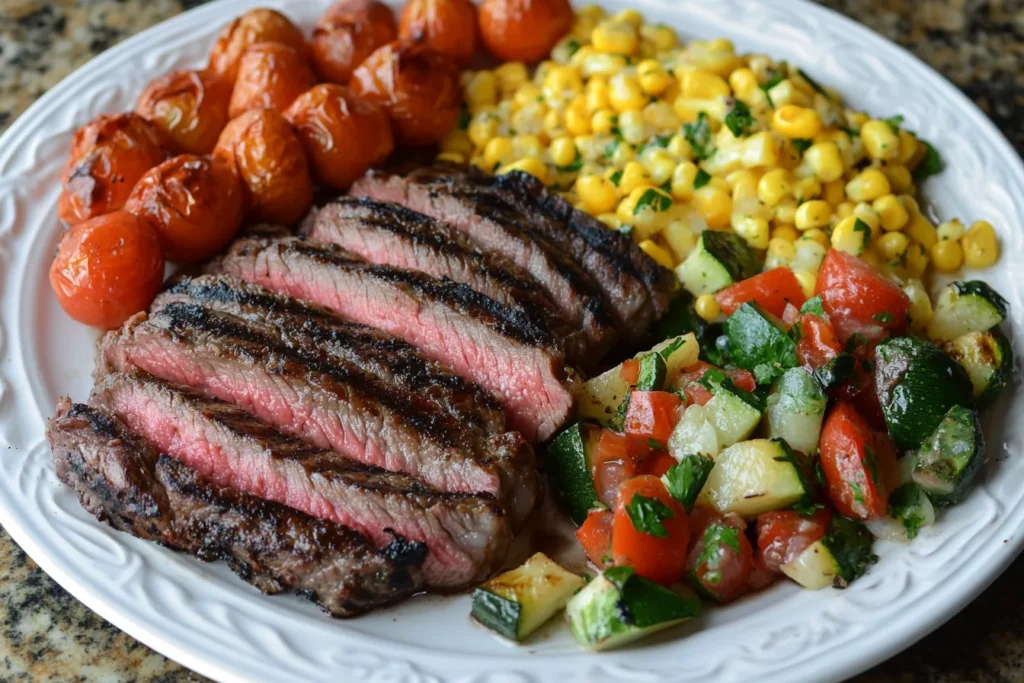
What Do Dietitians Recommend?
Registered dietitians emphasize:
- Moderation: Limit red meat to 2-3 servings per week.
- Quality: Choose grass-fed, organic options for the best health benefits.
Insights from the Fitness Community
Fitness enthusiasts value skirt steak for its high protein and iron content because these nutrients not only support energy but also contribute to muscle repair and enhance endurance, making it an ideal choice for active individuals.
29. Personalizing Your Diet with Skirt Steak
Tailoring Intake Based on Health Goals
- For weight loss: Opt for smaller portions and lean cooking methods.
- For muscle gain: Pair with complex carbs like sweet potatoes for post-workout recovery.
Adjusting for Allergies and Intolerances
If red meat doesn’t sit well with you, you might consider trying plant-based alternatives like tofu or tempeh. These options, in addition to being rich in protein, are also easier to digest for some individuals, making them a great substitute.
30. Conclusion: Is Skirt Steak Healthy?
Skirt steak can be a healthy addition to your diet when consumed in moderation and prepared mindfully. It offers:
- High-quality protein for muscle health.
- Iron and zinc for energy and immunity.
- A flavorful base for nutrient-packed meals.
However, it’s essential to consider portion sizes, cooking methods, and overall diet balance to enjoy its benefits while minimizing risks. By making thoughtful choices, you can savor the delicious taste of skirt steak without compromising your health.
FAQs:
- Is skirt steak gluten-free?
- Yes, the steak itself is naturally gluten-free, but watch for marinades or seasonings that may contain gluten.
- Does skirt steak have more fat than ribeye?
- No, ribeye is typically higher in fat and calories compared to skirt steak.
- Can pregnant women eat skirt steak?
- Yes, if cooked to a safe internal temperature of 145°F to avoid foodborne illness.
- What makes skirt steak flavorful?
- Its marbling and close muscle fibers give it a robust, beefy taste.
- How does grass-fed steak taste?
- Grass-fed steak tends to have a leaner, earthier flavor compared to grain-fed varieties.
- Can diabetics eat skirt steak?
- Yes, when paired with low-carb sides and consumed in moderation.
- How do I store skirt steak after cooking?
- Allow it to cool completely, then transfer to an airtight container and refrigerate for up to 4 days.
- Does seasoning affect nutrition?
- Seasoning adds negligible calories unless it includes sugar or oil-based components.
- Is flank steak healthier than skirt steak?
- Flank steak is slightly leaner but has less flavor than skirt steak.
- Can skirt steak be used in slow cooking?
- Yes, it becomes tender and flavorful in stews or braises.
- Is skirt steak healthier than chicken?
- Skirt steak provides more iron and zinc, while chicken is leaner and lower in saturated fat.
- Does cooking process affect its nutritional value?
- Yes, grilling retains more nutrients compared to frying.
- What’s the best portion size?
- Stick to 3-4 ounces per serving.
- Can I eat skirt steak daily?
- It’s best to limit red meat to 2-3 servings per week.
- Is grass-fed steak worth it?
- Yes, it’s higher in omega-3s and more sustainable.
- Does marinating improve health benefits?
- Marinating reduces carcinogen formation during grilling.
- Is skirt steak good for keto?
- Absolutely, its high fat and protein content make it keto-friendly.
